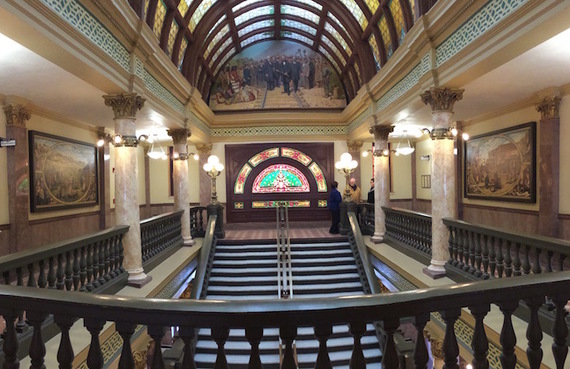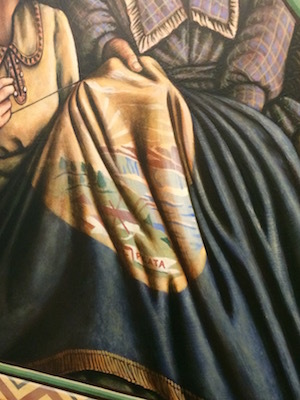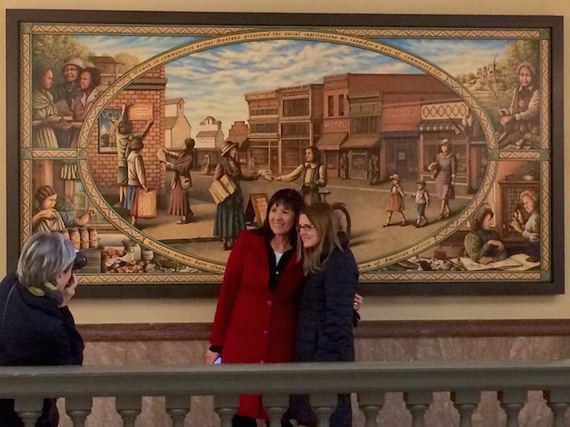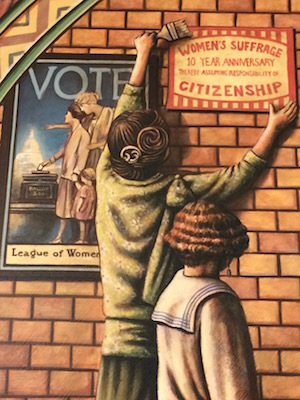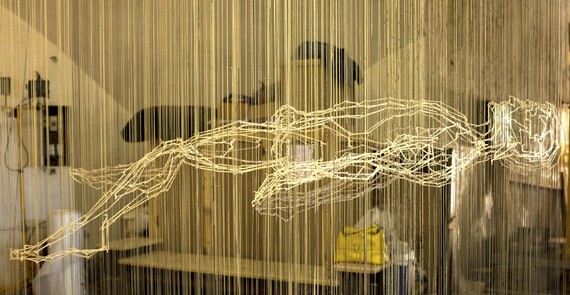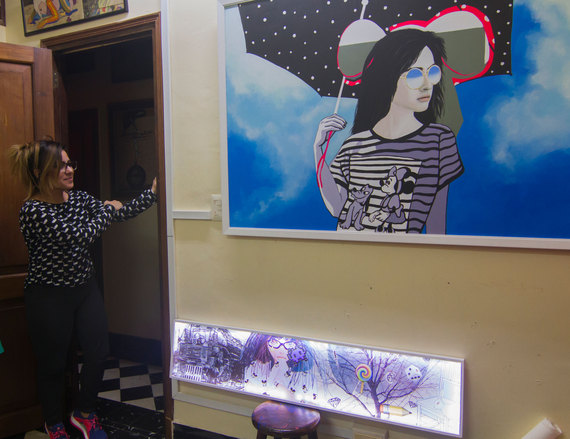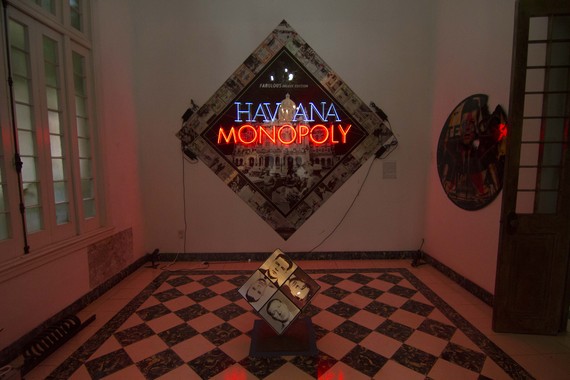First, A Salutation to Hanuman
Hanuman, the "monkey grammarian" of Octavio Paz's book by the same name, stands beautifully in the Asian Art Museum in San Francisco. His eyes look sparkling and alive, his face reveals the enunciation of a word, wonderful and pleasing no doubt, and his body is alert and his finger is raised. Hanuman is making a point, obviously, and he
looks so delighted in the act of speaking (to his beloved Ramayya and Sitamma possibly), that we can only wonder at the beauty of the thoughts that must be in his mind.
When I picture Hanuman it is often in depictions of his physical prowess and accomplishment, in flight usually, with the mountain in his palm. But this Hanuman, embodiment of the perfect word, kind Hanuman, impeccable Hanuman, the friend who appears and wins Rama over with the perfection of his speech, this is how I will now think of and adore him when I write, speak, and indeed, think of him.
Along with this speaking Hanuman, there are many other treasures on display at the exhibit; painting scrolls with vivid Jatayus, elegantly beautiful and divine Sitas, towering stone Ramas and Hanumans, and numerous pop culture nods as well. Projectors played loops of Doordarshan type Ramayanas, as well as Southeast Asian dance drama. It was a good museum experience. But then, we might ask the question that critics of colonialism and cultural appropriation have asked many times before: it is art, sure, but is it just art?
Just who is speaking for this living tradition here? Is it anyone close to having a sense of the fact that this tradition for many of us is indeed life itself? We name our children for Rama and Sita and confront our fears and illnesses with the name of Hanuman. We measure our pains and triumphs by the ordeals and deeds of our gods. We have lived and died for them, from Hampi to Ayodhya. And, for the most part, we have not killed, harmed, or even hated in return. We have pushed ourselves enough to preserve and protect our meanings, and even that we often concede, when we walk into the university classroom, the literary festival, and sadly, yes, the museum. A people who have absorbed desecration and a commitment to mere survival will not see more, instantly at least. But more, there certainly is.
Tales of Power
Consider the ways in which the "
Rama Epic" is presented. That the title of the epic is punctuated with some sort of a literary hobby-kit is obvious enough: "Hero, Heroine, Ally, Foe." Would four non-English names, a simple Rama, Sita, Hanuman and Ravana be too taxing for the museum-goer to see and learn? We don't go to the Uffizi in Florence and find words saying "martyr," "child-killer" or "father-eater" for their mythological characters. We are expected to just know their names. But why, in this day and age, in cool San Francisco at that, do the gatekeepers of the Ramayana tradition, somehow think that it is their mediation, their expertise and authority, that should be foregrounded?
I doubt that anything would have been lost in the Rama exhibit for immersing visitors into its world, our world, simply. Yet, from the giant banners that greet the visitor from the top of the museum announcing "Hero, Heroine, Ally, Foe" to the relentless use of words like "character, action, setting, plot" and the like, what we are being invited into is not a humbling, honest and direct observation of a tremendous cultural phenomenon but a subjugation into the colonizer's gaze instead.
Consider the main description of the exhibit on the website: "Bloody battles, passionate romance and a shape-shifting monkey warrior... discover and be thrilled by one of the world's greatest works of literature." Someone must have been munching some imaginary popcorn with that sort of attitude. And interestingly, another exhibit there is titled "The Goddess: Images of Power," and tells us that the "goddesses of Asia range from bloodthirsty destroyers to heroic warriors," and at best "benevolent wish-granters." But that one word a billion people and more know their Goddesses by is absent: Mother. One comforts one's self that most of the Indian tourists there will just say "Ammavaru" or "Durga Ma" when they see her (and contrary to academic myth, thinking of her as a mother in no way reduces our capacity to be in awe of her feminine and some might say feminist power).
The museum states that there are 135 art works on display in the Rama exhibit. On occasion, the texts introducing them add, in addition to the usual art and literature terminology, a word or two like "sacred" or "divinity." One might be tempted to think that perhaps that is all the sacred deserves, a passing acknowledgment ("the story... is also, for many, a sacred tradition"). And the language of the presentation is not necessarily disrespectful, or outlandish (no theories about the "side-hero" secretly having "sexual tension" with the "heroine" while the "hero" chases a deer in the manner of an alternative historian of the Hindus). Well-meaning families who come to see the exhibit with their parents and grandparents visiting from India would probably not be too puzzled by the politely scholarly tone even.
And yet, there is that very real and obvious odor of orientalism and cultural appropriation, and unlike the old days, this time it is so finessed you will need to be a propaganda expert to realize you are being marketed to, and marketed down to, just like those at the wrong end of the old civilizing missions did.
The danger of the museum discourse is that it is not inaccurate. It is inadequate. And perhaps, even if that limitation is not nominally intentional, it is in its professionalism and use of privilege very deliberate indeed.
There is a formidable stone statue of Rama from Vijayanagar on display. His left arm with the bow, and a large part of the left side of his body are missing. There are other artefacts too with signs of mutilation and savagery. There is no mention anywhere of the cause. On the other hand, in another part of the museum, a charming painting by M.F. Hussain is used as an occasion to express genteel puzzlement at how some Hindus could have ever got upset with him.
The Silenced Chisel
The act of reducing Rama to the Ramayana and the Ramayana to literature is not innocent. On the one hand, the self-relativizing distance of seeing one's beloved deities as character-prototypes ("ally" et al) is perhaps educational in its own way. A certain sort of mythologist might like it. Yoked to some bhakti, it might even hold some ethical-pedagogical water. It has its place. In India, with temples and with people who live by them still (the subaltern billion whose devotion, whose Hindu devotion, somehow vanishes from accounts about them by those who speak for them in academia, unfortunately), the proliferation of elite-driven Pop Po-Mo Hinduism doesn't still have a monopoly on the narrative. Pop Po-Mo might persuade its elite base, and some aspirational secularists, but the bodies of grandmothers and grandfathers and gurus and TV gurus in the vernacular are all there, for good and for bad.
In America, though, that discourse holds a fanatical monopoly. Its products are everywhere. In classrooms, in the media, in the museum in the way in which our gods are presented, and in the finely curated reading the museum bookstore has to offer. One definition of culture, one definition of kitsch, one ring to rule them all...
What then might a museum and its expert advisors do? Is there a better way of presenting (or representing) Rama and his world to the museum audience in a way that is true to those who live in its world still? Surely, the choices are not simply between a sterile, objectifying outsider's museum gaze and the insider's supposedly blind and "religious" kind of "faith" in his "idols." Both are inventions and both must be overcome.
It is telling that there is not one photograph of an actual temple of Rama in India in the exhibit, let alone photos of devotees or devotion. There is a nod to the fact that Ramayana is a "living tradition" but that is not what life or tradition really means is it? To the grand narrator in his or her postmodern purview, the "living tradition" of the Ramayana only means that anyone (in his or her charmed circles) can say whatever they want about it, apparently. They can "do politics" around it, mostly based on a baseless colonial-racist theory about light and dark skinned people which falls apart before the reality of complexions in any temple but they do politics, sure. They will even burn Rama's effigy and claim Ravana as the good guy in their war against Brahmanical-Aryan hegemony (another matter that Ravanabrahma as we called him was seen as a Brahmin by some of us). No, that's not a "living tradition" in the sense that Rama's India sees it at all.
What is a living tradition? For one thing, it is right there all around the Asian Art Museum too. Drive a few miles South or East from there in the Bay Area and you have one of the largest clusters of living Hindu temples in North America, and of course, one of the largest and most eclectic collections of Hindu Americans living here as well. Does the museum so much as acknowledge the existence of this world? That the same Rama and Hanuman who stand here in the museum, some of them mutilated, missing an arm or ornament, are also right there in the temples, alive to those who behold them, alive not only in their hearts and "beliefs" but visibly, palpably so in the practices that herald their existence day after day as well?
And even in talking about the past, do we not have an obligation to truthfully recognize a few things at least about who the people who breathed shape and meaning into these "artefacts" were? Were the ancient people of Vijayanagara mere consumers of "Rama-literature"? Or "art," in the museum sense, or South Asianness in the postmodern sense perhaps? I am reminded of a panel I was on in a literature festival a few months ago where a fellow panelist insisted that Rama and Krishna were fictional characters. I do not know if people build temples and conduct elaborate ceremonies for Sherlock Holmes or Harry Potter. And I seriously doubt that the devotees at Vithala or Hazara Rama or Yantrodharaka were going there to be amused or even distracted.
No. They were the ancestors of the same people who live all around your circle of privilege in the museum, even now.
I do not know what right the custodians of "art" have to take Rama out of his world that brazenly. But having sought to secularize what was actually not even really "religious" in the Western sense at all, they have forgotten everything, even the artists who live in this world of Rama and Sita and Hanuman in ways that the theorists don't quite know how to represent it appears. And it is not too difficult at all.
In the Satyanarayana Swami temple in Milpitas (far closer to the museum by the way than Cambridge, Massachusetts from where expert speakers came), a descendant of the Sthapati family teaches children and adults about the rules of traditional sculpture in small, inexpensive classes every weekend. His ancestors built the temples, the loot from which now adorns museums. He is right here in the Bay Area, helping to build temples and a love of their beauty to children, without forgetting the precision, the knowledge and the sanctity which makes up this world. Does the museum, or shall I say, "Museum," even know he exists? Would it invite him to speak, along with all the academic experts and professional "story-tellers" it has lined up on the weekends? Could we hear the music of Tyagayya or Purandara Dasa or the words of Tulasidas there perhaps? Is anything being done to help visitors connect the dots between artefact, music, memory, and the future, and I mean the future beyond the fantasy-art world?
Exit
In the textual sarcophagus that is the museum, I did not see myself. I did not see my family, my past, or my future (or maybe I saw that future and did not like it at all). I saw only the inevitability of endless appropriation, erasure, silencing, denial, and ultimately cultural destruction, all the things that precisely the nice people who put together shows like this would believe that they want to avoid. Even as the museum preserves objects perfectly, it renders them lost to generations of children and grandchildren. They may be smart enough to recognize racism and supremacism when they see it, but are unequipped to fight it still by generations of parents and grandparents who were too busy working in post-McAulay India to have figured out how to enshrine and express what it was they felt, who they were before their Rama, just right, just so, just enough for the future of their civilization to know it too.
You walk out, and in the museum bookstore you see more of the same, the highly learned and credentialed academic books on Hinduism and South Asia, the same old colonizer's gaze, now recast into a mercenary subaltern premise, promising to liberate Hitler's victims, Aryan Invasion (aka Migration) victims, the real and unreal all mixed up, all dolled up and going nowhere close to the heart of the soul that Hanuman, with his brilliant thought steeped in friendship and perfection, seems to want you to go.
Lovely books at the store, handsome university-press interventions into the meaning of everything in South Asia. But I missed the presence of the footpath book-stalls of the sort you see outside temples in India. One or two selections from there in the museum store would have been nice.
First published in
Creative India -- This feed and its contents are the property of The Huffington Post, and use is subject to our terms. It may be used for personal consumption, but may not be distributed on a website.

































